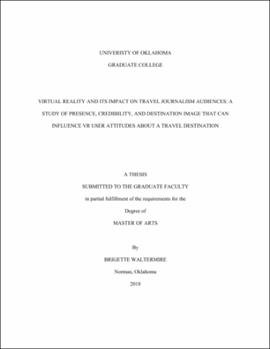| dc.description.abstract | Virtual reality technology is becoming more common in journalism storytelling as the technology develops. However, the technology can require highly technical skills to operate, compose, and produce a product, which is not always a viable or affordable option for smaller newsrooms or freelance journalists. This thesis examined how a VR 360-degree photo display paired with an audio voice track could impact a travel journalism story, and the audience’s feeling of presence, destination image, and perceived credibility could be changed when experiencing the story through a VR headset built to display a 360-degree image on a phone compared to a flat-screen image paired with an audio voice track.
This study was a 2 (2 destinations with corresponding audio) x 2 (medium: 360-degree photo display with VR headset view or full-screen view of the 360-degree photo on handheld phone) repeated measures experiment, where destination is a with-subjects’ factor and the medium is a between-subjects factor. Participants were randomly assigned to the between-subjects’ factor, and the order of the with-subjects factor was randomly assigned to participants. Participants were shown 360-degree photos of the Eiffel Tower in Paris, France, and part of the Acropolis featuring the Pantheon in Athens, Greece. A minute-long audio travel journalism story about the destination was paired with the corresponding 360-degree photo. This study sought to determine media differences in presence, credibility, and destination image between experimental conditions.
Repeated measures and mixed design analysis of variance tests were run on the data in SPSS to answer the 2 hypotheses and 3 research questions posed in this study. Results indicated that there was a significant increase in feeling of presence in the VR condition compared to the flat-screen condition. The outcomes, limitations, and conclusions are discussed in the corresponding sections of the paper.
Keywords: virtual reality, destination image, immersive journalism, presence, credibility, medium, travel journalism, 360-degree photo | en_US |
